 |
01670 732139 |
 |
steve@itseasy.co.uk |
Shape Connections in Microsoft Visio
BASIC DIAGRAMS
The following example shows some of the basic drawing principles. To add shapes simply drag them on to the drawing canvas. Shape connections, types and methods of changing connections are covered later.

Several shapes are positioned onto the drawing canvas.

When you drop the shape on the grid it will snap to the nearest grid line.
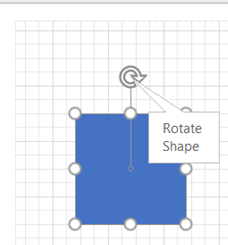
The white circles facilitate size changes; the small circle at the top of each shape provides rotation options.
When the connector tool is activated shapes display connection points when the mouse hovers over the shape.
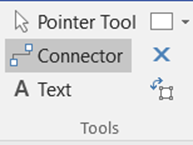
Some of the shapes will have yellow circles (Control handles) these have distinctive features for each shape. If you hold your mouse over the shape, you will see a text box description as shown below.

If you want to move several shapes in one go, you can use your shift key to select each shape or drag over them with your mouse and then move them as a group.

There are two types of shapes, one-dimensional and two-dimensional as shown below.

CONNECTING SHAPES
In Microsoft Visio, drawings such as flowcharts, block diagrams and organisational charts are all connected drawings.
There are three main types of connector in Visio, Inward, Outward and Inward/Outward.
Inward connectors:
Most shapes have inward connection points, which means that you can glue connectors or other shapes with Outward connectors to them. (Black Squares)

Outward Connectors:
A 2-D shape with an Outward connection point can be glued to another 2-D shape with an Inward connection point. Right click on the connection point to change the type. Firstly, activate the Connection Tool.
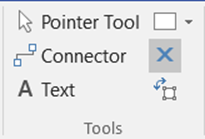
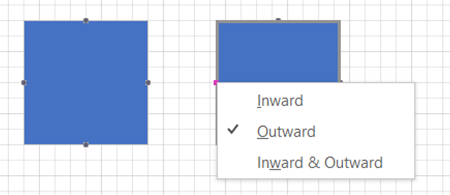
Once the connector is changed it will glue to the Inward connector on the other shape and move as one.

Inward/Outward Connector
Use inward/outward connection points to allow shapes to be glued together in any order. An inward/outward connection point behaves like an inward connection point when you glue a 1-D connector or the outward connection point of a 2-D shape to it. It behaves like an outward connection point when you glue it to another 2-D shape. For example, in the Office Layout template, the work surface shapes have inward/outward connection points at each end so that work-surface components can be glued together in any order.
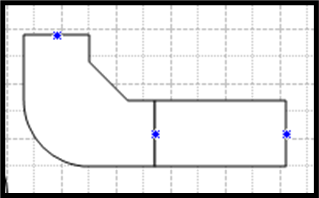
When you create your own shapes, you can set their connection point type.
Use inward connection points in drawings that use connectors (connector: Any one-dimensional (1-D) shape that can be glued between two shapes in a drawing to connect the shapes.) to connect shapes, such as flowchart diagrams.
Use inward or outward connection points when you want to glue 2-D shapes together in a particular direction or order. For example, in an office layout diagram, if you want outlet shapes to be attracted to walls:
Set the outlet shape to have an outward connection point.
Add inward connection points to the Wall shape (perhaps spaced according to electrical wiring code).
Use inward/outward connection points to allow shapes to be glued together in any order. For example, if you have a wall shape with inward/outward connection points, it won’t matter which wall segment you drag first; it will always glue to another shape. However, if you have an outward connection point on one end of the wall and an inward connection point on the other end, you will need to drag the outward end to an inward end to glue the walls together.
There are two types of glue in Visio
Shape to Shape and Point to Point
Shape to Shape
With shape-to-shape glue (also known as dynamic or “walking” glue), a connector stays glued to shapes by moving to the closest available connection points as the shape is repositioned.
Point to Point
With point-to-point glue (also known as static glue), a connector stays glued to its specific connection point on each shape when you reposition the shapes.
A shape’s connection point turns red when you glue a connector to a specific point on a shape.
To create a shape-to-shape connector, click the connector tool on the toolbar.
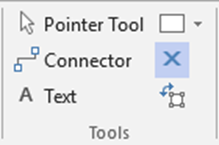
Drag the first shape into position and leave it selected then drag the second shape into position. The connector will snap into place.

Shape – To – Shape the outline on the boxes turn green as you float over them (not over a connection point).

When the shape is moved the connector moves to the nearest point.

Point-to-Point connections
Use the pointer tool to drag two shapes on to the grid.
Click the connector tool and hover over the first shape until the connection point is highlighted, then drag to the other shapes connector point.

If you move either of the shapes, the connection will be glued to the original position.

Although shapes have pre-set connection points, you can add additional connection points by selecting the connection tool.

Hold the Control Key down and click on the shape to apply the new connection point or points.
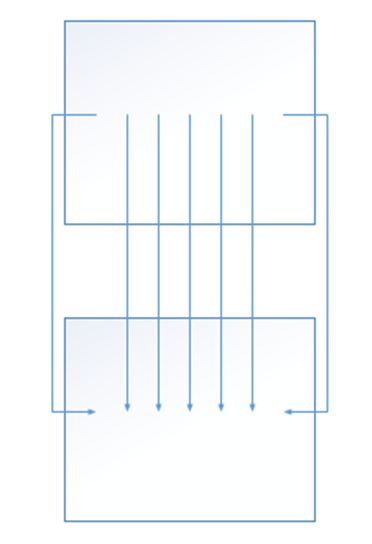
You can use the connector tool to join the new connection points as shown above.
Remember connection point properties are changed by right clicking the point.

Courses
Search for courses here
Search for online courses here
Testimonials
 “I studied with Steve when we completed our CiPD CTP together. During the course I found Steve to be very personable and also very professional. Steve was first on my list of suppliers. Steve was very competitively priced and very accommodating.”
“I studied with Steve when we completed our CiPD CTP together. During the course I found Steve to be very personable and also very professional. Steve was first on my list of suppliers. Steve was very competitively priced and very accommodating.”
Simon Snowdon
European Training Manager at HP Enterprise Services
 “Steve’s background in IT training clearly provided him with great organisational and managerial skills which he put to good use at Second Chance Enterprises. His ability to see the long term strategy as well as manage the day to day management is one of his biggest strengths.”
“Steve’s background in IT training clearly provided him with great organisational and managerial skills which he put to good use at Second Chance Enterprises. His ability to see the long term strategy as well as manage the day to day management is one of his biggest strengths.”
Chriss Graham
Project Coordinator at Daisy Group

Craig Forster
Estimator, John F Hunt Regeneration Ltd
 “Steve delivered a number of Microsoft Office Training Sessions to a range of employees across Newcastle College. The service provided by Steve is second to none. I have no hesitations in recommending him to other employers.”
“Steve delivered a number of Microsoft Office Training Sessions to a range of employees across Newcastle College. The service provided by Steve is second to none. I have no hesitations in recommending him to other employers.”
Christine Jackman
Learning Manager(North) - Winner of Training Programme of the Year NECCA




